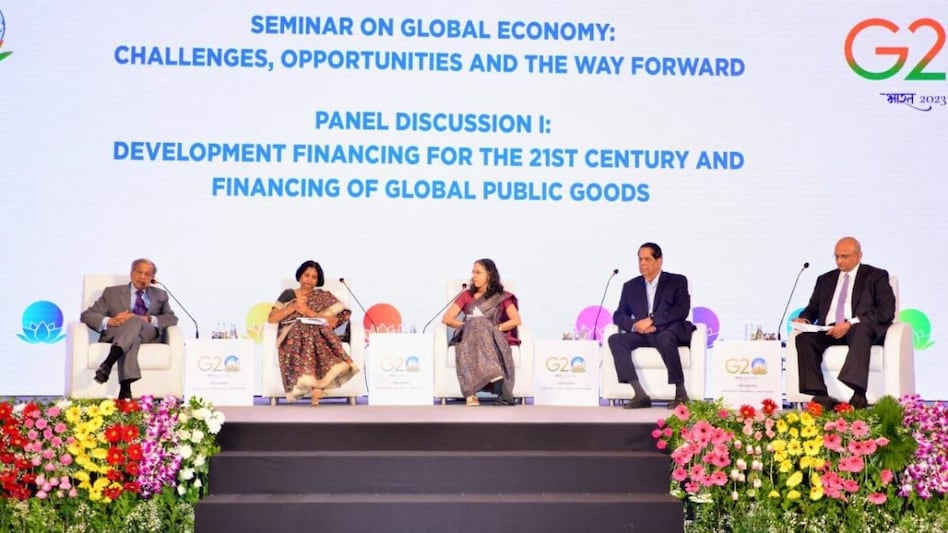 Callable capital in the MDBs has never been called out in the history of these institutions. -16:9
Callable capital in the MDBs has never been called out in the history of these institutions. -16:9
 Callable capital in the MDBs has never been called out in the history of these institutions. -16:9
Callable capital in the MDBs has never been called out in the history of these institutions. -16:9The multilateral development banks (MDBs) like International Monetary Fund (IMF) and the World Bank were set up nearly 80 years ago. The rules of the game in the financial system are changing very fast. MDBs need a roadmap for the 21st century, which includes optimisation of their balance sheets, better operating model, improved efficiency via technology and other means, innovative forms of lending products , leveraging private capital etc. to make a more impact in the developing world, which is in dire need of capital especially for climate change. The reforms at the MDBs are also a key item in India's G20 Presidency. In a seminar on the global economy organised by the Department of Economic Affairs and Reserve Bank of India (RBI) in Mumbai on Friday, the who's who of the financial world discussed some of the suggestions for reforming the MDBs. Let’s read the new template of reforms:
Better operating model to reduce cost and faster decision making
Be it the IMF or the World Bank, there is no doubt that these institutions with decades of existence need to improve their operating model. They need to speed up the delivery mechanism. "There is a lot of work currently underway on how we need to improve and change our operating model. These are not easy things to do and it will take time , but we have started the work," said Anshula Kant, Managing Director and chief financial officer at World Bank. K V Kamath, who built the BRICS- sponsored New Development Bank from scratch, said that one of the fundamental principles is to keep the operating cost low. "You need to be able to take brave decisions to implement technology at unheard of cost. You also need to keep the appraising cycle lower," said Kamath. The World Bank is also working very closely with other MDBs in harmonisation of delivery standards so that it makes life easier for the borrowing countries.
Innovative financing solutions
There is also a need for MDBs to come out with innovative financing solutions for increasing the resources for the developing world. "Our shareholders have agreed to increase our risk appetite. We have reduced our equity to loan ratio by 1 per cent. That has added USD$4 billion per annum," says Kant. The World Bank , which leverages its capital about 5 times, is working on new financing instruments like hybrid capital and portfolio guarantee platforms to allow higher leverage to the bank. The new instruments will allow higher lendable resources to the developing countries.
More clarity on callable capital
Callable capital in the MDBs has never been called out in the history of these institutions. There are a lot of intricacies in the callable capital. There is no clarity on the trigger, process, procedure around, parliament or congress approval, if any, for the callable capital. The World Bank has started working on the callable capital from December last year. "We are working with the largest shareholders to see if we can bring more clarity. We are also talking to credit rating agencies so that they also understand and give more weightage to callable capital when they rate MDBs," said Kant.
Need for leveraging private capital
MDBs' record of harnessing private capital is 0.6 per cent , which is less than 1 per cent of their equity capital. "It is also about the tenor of the loans. There are loans with tenor of 20-50 years. It is difficult to get private capital with such a long tenor," defended Kant. N K Singh committee, under the aegis of G-20 , in its report has made a case for higher share of private capital. Ashima Goyal, Professor at Indira Gandhi Institute of Development Research suggested that the MDBs, regional institutions, local development institutions should cooperate, compete and also join innovation platforms.
Using the credit rating tool to mobilise more capital
There are also suggestions for reducing the triple A status of MDBs, which will open the doors for raising more funds at a slightly higher cost. Kant , however, disagrees. "We borrow about $50 billion every year from the bond market. We are one of the largest non-sovereign issuers in the world. Borrowing $50 billion with a triple A rating is a whole different ball game than borrowing with double A or triple B. The scale and size matter," said Kant.